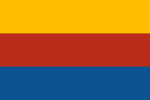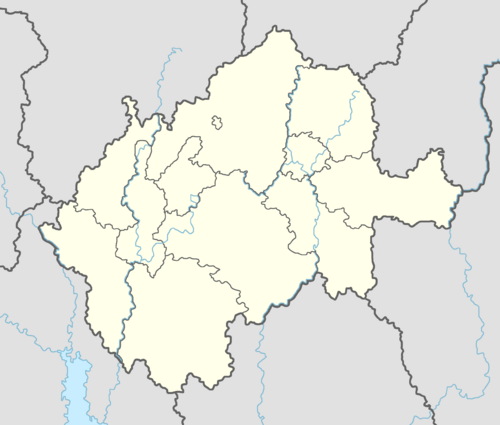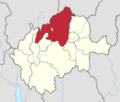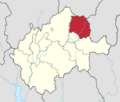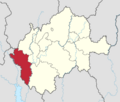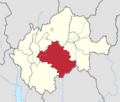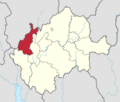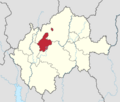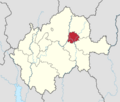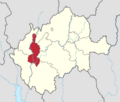Walneria: Difference between revisions
mNo edit summary |
m (→History: spelling + wikipedia links) |
||
| Line 149: | Line 149: | ||
TBA | TBA | ||
===Slavic migration=== | ===Slavic migration=== | ||
At the beginning of the 7th century, first | At the beginning of the 7th century, the first {{wp|Slavs}} started arriving from the west, quickly settling most of the area by the end of the 7th century. Early records show, that most of the cities and villages were majority Slavic. The newly formed duchies of Saldania (capital in Blanov), Walneria (capital in Kusnavice) and Kranelia (capital in [[Tyrámen|Rámovny]]) were majority Slavic duchies. | ||
===Westsiedlung=== | ===Westsiedlung=== | ||
[[File:WalnerianSlavicSettlements.png|thumb|Shrinking of the Slavic settlements in Walneria]] | [[File:WalnerianSlavicSettlements.png|thumb|Shrinking of the Slavic settlements in Walneria]] | ||
In early 12th century, Dolchic people in the east initiated an activity named "Westsiedlung" (literally "Western settlement"), which included many | In early 12th century, Dolchic people in the east initiated an activity named "Westsiedlung" (literally "Western settlement"), which included many Dolchic tribes, specially {{wp|Middle High German|Middle High Dolch}} migrating into the territory of present day Walneria, creating multiple linguistic bridges and disrupting Slavic settlements. This process was mostly seen positively by the rulers of both duchies and the later formed Kingdom of Walneria, as incoming Dolchic settlers improved the strength and economy of the kingdom. | ||
By early 15th century, most border regions as well as the central highlands were majority | By the early 15th century, most border regions as well as the central highlands were majority {{wp|Middle High German|Dolch}}, which is when the [[Entenian Wars]] happened. | ||
===Religious conflict=== | ===Religious conflict=== | ||
{{Main|Entenian Wars}} | {{Main|Entenian Wars}} | ||
The [[Entenian Wars]] was a series of conflicts between | The [[Entenian Wars]] was a series of conflicts between {{wp|Catholic Church|Catholic}} royalty and a newly formed {{wp|Proto-Protestantism|proto-protestant}} movement, which gained traction under the preacher Peter Ente ([[Walnerian language|Walnerian]]: ''Petŕ Ente''; {{wp|Czech language|Ustokan}}: ''Petr Ent''), which eventually ended with the siege of [[Tyrámen|Rámovny]] in 1439. As a result of this conflict, many people were displaced by either fleeing local lords due to their faith or by being moved with their lord with reassignment to a new fiefdom. | ||
With the regions intermingled in many areas and a possible resurgence of religious tensions, the king Ignatio III. passed multiple decrees, which | With the regions intermingled in many areas and a possible resurgence of religious tensions, the king Ignatio III. passed multiple decrees, which labelled "Entist faiths" to be on equal footing with {{wp|Catholic Church|Catholicism}}. By the end of the 15th century, more than 3/4 of the country were Entist. | ||
===Zusamëlfasunk=== | ===Zusamëlfasunk=== | ||
{{Main|Walnerian language#Zusamëlfasunk|l1=Zusamëlfasunk}}{{See also|Walnerian language#History|l1=History of the Walnerian language}} | {{Main|Walnerian language#Zusamëlfasunk|l1=Zusamëlfasunk}}{{See also|Walnerian language#History|l1=History of the Walnerian language}} | ||
In [[Entenian Wars|the conflict]], Slavic settlements suffered heavy losses and were effectively destroyed, which resulted in Dolch settlers moving further back in. [[Walnerian language|Walnerian]] term "Zusamëlfasunk" (Literally "Fitting together") describes a process, in which the former | In [[Entenian Wars|the conflict]], Slavic settlements suffered heavy losses and were effectively destroyed, which resulted in Dolch settlers moving further back in. [[Walnerian language|Walnerian]] term "Zusamëlfasunk" (Literally "Fitting together") describes a process, in which the former Slavic settlers slowly Germanized and influenced the Dolch language in the area in process. The result was a version of the {{wp|German language|Dolch language}}, which was heavily {{wp|Slavicisation|Slavicised}} in phonology and orthography, as well as influencing the grammar and vocabulary (Example may include {{wp|Czech language|Ustokan}} ''obraz'' → [[Walnerian language|Walnerian]] ''obrós'' (in contrast to {{wp|German language|Dolch}} ''Bild'')). | ||
The resulting language was named of the country "[[Walnerian language|Walnerian]]" and quickly spread to many more | The resulting language was named of the country "[[Walnerian language|Walnerian]]" and quickly spread to many more Slavic settlements. By mid 18th century, {{wp|Obotrites|Rolamen}} Slavs were fully Germanised, while {{wp|Sorbs|Malenik}} and {{wp|Czechs|Ustokan}} linguistic areas were shrunk to only disconnected linguistic islands. | ||
====Cultural resistance==== | ====Cultural resistance==== | ||
At the end of the 18th century, a movement arose among the Slavic settlers, which aimed to stop the | At the end of the 18th century, a movement arose among the Slavic settlers, which aimed to stop the {{wp|Germanisation|Germanisation}} of their linguistic areas. The so called "Ustokan rebirth" and "Malenik rebirth" were processes, where Ustokan and Malenik linguists tried reforming the language and creating/taking new words from other {{wp|Slavic languages}} to replace {{wp|Germanism (linguistics)|Dolchisms}} (Example may include {{wp|Czech language|Ustokan}} ''luft'' → ''vzduĥ'' (from {{wp|Russian language|Russian}} ''{{Hover title|vozduha|воздуха}}'')). | ||
At the same time, Ustokan and Malenik authors started writing books and newsletters in their native languages, which boosted the cultural life in Slavic areas - some theatres started introducing plays in their Slavic languages. This linguistic purism launched patriotism, which de facto weakened the Walnerian position in | At the same time, Ustokan and Malenik authors started writing books and newsletters in their native languages, which boosted the cultural life in Slavic areas - some theatres started introducing plays in their Slavic languages. This linguistic purism launched patriotism, which de facto weakened the Walnerian position in Germanisation and de facto established the linguistic islands in which the Slavic languages are spoken today in Walneria. | ||
The other side of this is emigration. Currently, there are over 900,000 | The other side of this is emigration. Currently, there are over 900,000 {{wp|Czechs|Ustokans}} and 320,000 {{wp|Sorbs|Maleniks}} living in exile, which form a strong linguistic community, although some of them returned since 1980s autonomies were created. | ||
===Years of | ===Years of tyranny=== | ||
TBA | TBA | ||
===Independence=== | ===Independence=== | ||
| Line 182: | Line 182: | ||
{{Main|Stedorian-Walnerian War}} | {{Main|Stedorian-Walnerian War}} | ||
[[File:Čs._vojáci_v_Krásné_Lípě.gif|thumb|Walnerian soldiers in Starbov, [https://iiwiki.us/wiki/Stedorian-Walnerian_War#Mobilisation April 1939] ]] | [[File:Čs._vojáci_v_Krásné_Lípě.gif|thumb|Walnerian soldiers in Starbov, [https://iiwiki.us/wiki/Stedorian-Walnerian_War#Mobilisation April 1939] ]] | ||
Ever since the 1899 revolution, the new government got into political problems with [[Stedoria]], which eventually escalated into a diplomatic feedback loop, which in turn lead to the war. | |||
The war started on May 1st, 1939, when [[Stedoria|Stedorian]] forces crossed Walnerian border and advanced into the mainland, being successful in their offensive at first. After the first line of defence was breached, the Walnerian forces retreated to the second line. In Summer, unsuccessful Walnerian offensive only complicated the situation, as forces on both sides were too exhausted to conduct any large attack. | The war started on May 1st, 1939, when [[Stedoria|Stedorian]] forces crossed Walnerian border and advanced into the mainland, being successful in their offensive at first. After the first line of defence was breached, the Walnerian forces retreated to the second line. In Summer, the unsuccessful Walnerian offensive only complicated the situation, as forces on both sides were too exhausted to conduct any large attack. By autumn and in winter, the [[Stedoria|Stedorian]] forces deployed in the occupation zones crippled major shortages in clothing and food, as the supply lines and logistics crumbled, and they were forced into a retreat. In March the next year, the border was restored to the pre-war location and Walneria ended victorious in the defensive war. | ||
===Post-war development=== | ===Post-war development=== | ||
Revision as of 18:02, 27 October 2021
This article is incomplete because it is pending further input from participants, or it is a work-in-progress by one author. Please comment on this article's talk page to share your input, comments and questions. Note: To contribute to this article, you may need to seek help from the author(s) of this page. |
Confederacy of Walneria Rósberisse Konfederación
| |||||||||
|---|---|---|---|---|---|---|---|---|---|
Motto: Curyk Veltëm mit Myheŕ Back to the wurld with dedication | |||||||||
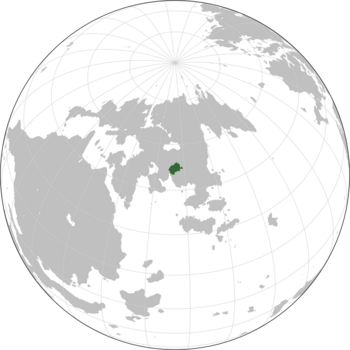 Location of Walneria in Argis | |||||||||
| Capital | Tyrámen | ||||||||
| Official languages | Walnerian | ||||||||
| Recognised regional languages | Ustokan Upper Malenik Lower Malenik Stedorian | ||||||||
| Government | |||||||||
• President | Gyntŕ Ssvarc | ||||||||
• Prime Minister | Zimón Novak | ||||||||
| Legislature | National Assembly | ||||||||
| Area | |||||||||
• | 89,520 km2 (34,560 sq mi) | ||||||||
• Water (%) | 2% | ||||||||
| Population | |||||||||
• 2021 estimate | 10,612,108 | ||||||||
• 2018 census | 10,612,941 | ||||||||
| GDP (PPP) | estimate | ||||||||
• Total | 0 billion GK$ (0 billion WKR) | ||||||||
• Per capita | 0 GK$ (0 WKR) | ||||||||
| GDP (nominal) | estimate | ||||||||
• Total | 0 billion US$ (0 billion WKR) | ||||||||
• Per capita | 0 US$ (0 WKR) | ||||||||
| Gini | 28 low | ||||||||
| HDI | 0.897 very high | ||||||||
| Currency | Walnerian Króne (Ԟ) (WKR) | ||||||||
| Time zone | UTC-1:00 (DIT) | ||||||||
• Summer (DST) | UTC+0:00 (DIST) | ||||||||
| Calling code | +620 | ||||||||
| Internet TLD | .wn | ||||||||
Walneria (Walnerian: Rósberland), officially the Confederacy of Walneria (Walnerian: Rósberisse Konfederación) is a country located on the continent of Argis, bordering Stedoria and Dazhdinia. It is a democratic unicameral neutral country.
History
Prehistory
TBA
Celtic and Dolchic eras
TBA
Slavic migration
At the beginning of the 7th century, the first Slavs started arriving from the west, quickly settling most of the area by the end of the 7th century. Early records show, that most of the cities and villages were majority Slavic. The newly formed duchies of Saldania (capital in Blanov), Walneria (capital in Kusnavice) and Kranelia (capital in Rámovny) were majority Slavic duchies.
Westsiedlung
In early 12th century, Dolchic people in the east initiated an activity named "Westsiedlung" (literally "Western settlement"), which included many Dolchic tribes, specially Middle High Dolch migrating into the territory of present day Walneria, creating multiple linguistic bridges and disrupting Slavic settlements. This process was mostly seen positively by the rulers of both duchies and the later formed Kingdom of Walneria, as incoming Dolchic settlers improved the strength and economy of the kingdom.
By the early 15th century, most border regions as well as the central highlands were majority Dolch, which is when the Entenian Wars happened.
Religious conflict
The Entenian Wars was a series of conflicts between Catholic royalty and a newly formed proto-protestant movement, which gained traction under the preacher Peter Ente (Walnerian: Petŕ Ente; Ustokan: Petr Ent), which eventually ended with the siege of Rámovny in 1439. As a result of this conflict, many people were displaced by either fleeing local lords due to their faith or by being moved with their lord with reassignment to a new fiefdom.
With the regions intermingled in many areas and a possible resurgence of religious tensions, the king Ignatio III. passed multiple decrees, which labelled "Entist faiths" to be on equal footing with Catholicism. By the end of the 15th century, more than 3/4 of the country were Entist.
Zusamëlfasunk
In the conflict, Slavic settlements suffered heavy losses and were effectively destroyed, which resulted in Dolch settlers moving further back in. Walnerian term "Zusamëlfasunk" (Literally "Fitting together") describes a process, in which the former Slavic settlers slowly Germanized and influenced the Dolch language in the area in process. The result was a version of the Dolch language, which was heavily Slavicised in phonology and orthography, as well as influencing the grammar and vocabulary (Example may include Ustokan obraz → Walnerian obrós (in contrast to Dolch Bild)).
The resulting language was named of the country "Walnerian" and quickly spread to many more Slavic settlements. By mid 18th century, Rolamen Slavs were fully Germanised, while Malenik and Ustokan linguistic areas were shrunk to only disconnected linguistic islands.
Cultural resistance
At the end of the 18th century, a movement arose among the Slavic settlers, which aimed to stop the Germanisation of their linguistic areas. The so called "Ustokan rebirth" and "Malenik rebirth" were processes, where Ustokan and Malenik linguists tried reforming the language and creating/taking new words from other Slavic languages to replace Dolchisms (Example may include Ustokan luft → vzduĥ (from Russian воздуха)).
At the same time, Ustokan and Malenik authors started writing books and newsletters in their native languages, which boosted the cultural life in Slavic areas - some theatres started introducing plays in their Slavic languages. This linguistic purism launched patriotism, which de facto weakened the Walnerian position in Germanisation and de facto established the linguistic islands in which the Slavic languages are spoken today in Walneria.
The other side of this is emigration. Currently, there are over 900,000 Ustokans and 320,000 Maleniks living in exile, which form a strong linguistic community, although some of them returned since 1980s autonomies were created.
Years of tyranny
TBA
Independence
TBA
Defensive war

Ever since the 1899 revolution, the new government got into political problems with Stedoria, which eventually escalated into a diplomatic feedback loop, which in turn lead to the war.
The war started on May 1st, 1939, when Stedorian forces crossed Walnerian border and advanced into the mainland, being successful in their offensive at first. After the first line of defence was breached, the Walnerian forces retreated to the second line. In Summer, the unsuccessful Walnerian offensive only complicated the situation, as forces on both sides were too exhausted to conduct any large attack. By autumn and in winter, the Stedorian forces deployed in the occupation zones crippled major shortages in clothing and food, as the supply lines and logistics crumbled, and they were forced into a retreat. In March the next year, the border was restored to the pre-war location and Walneria ended victorious in the defensive war.
Post-war development
TBA
Demographics
| Linguistic areas of Walneria | ||||||||||||||
|---|---|---|---|---|---|---|---|---|---|---|---|---|---|---|
| Chart of the languages | ||||||||||||||
Native languages in Walneria Walnerian (91.7%) Ustokan (3.6%) Upper Malenik (1.7%) Lower Malenik (1.6%) Stedorian (0.9%) Other (0.5%)
| ||||||||||||||
TBA
Settlement areas
TBA
Ustokan settlement area
TBA
Malenik settlement area
TBA
Geography
TBA
Administrative divisions
| Regions of Walneria | |||||||||||||||||||||||||||||||||||||||||||||||||||||||
|---|---|---|---|---|---|---|---|---|---|---|---|---|---|---|---|---|---|---|---|---|---|---|---|---|---|---|---|---|---|---|---|---|---|---|---|---|---|---|---|---|---|---|---|---|---|---|---|---|---|---|---|---|---|---|---|
| Table of the regions | |||||||||||||||||||||||||||||||||||||||||||||||||||||||
| |||||||||||||||||||||||||||||||||||||||||||||||||||||||
TBA
Climate
TBA
Government and politics
Legislature
The legislature of Walneria is unicameral, with the National Assembly serving as the meeting place where laws are discussed and passed. The assembly has 129 seats, 80 of which are currently controlled by the governmental coalition of the Liberals (L.P.R.) and Christian Democrats (K.D.P.R.).
| National Assembly political distribution: | |||||
|---|---|---|---|---|---|
|
Assembly Speaker allegiance: L.P.R.
| |||||
| Color | Name of the Political Party | Nick used by the Political Party | Political direction | Number of seats | Affiliation |
| #00E3E0 | Liberal Party of Walneria | Liberals | Liberal centre-right | 57 | Coalition |
| #FFD500 | Christian Democratic Party of Walneria | Christian Democrats | Christian democracy | 23 | Coalition |
| #282FFF | National party of Walneria | Nationalists | Isolationism | 18 | Opposition |
| #3FB400 | Green Movement | Greens | Eco-centric centre-left | 11 | Unaffiliated |
| #FF8300 | Social Democratic Party of Walneria | Social Democrats | Populist mid-left | 8 | Opposition |
| #C60000 | Worker's Party of Walneria | Communists | Marxist far left | 6 | Opposition |
| #A100B4 | Party of National Rebirth | Rebirthists | Centrist anarchism | 4 | Unaffiliated |
| #545454 | Walneria First Movement | REBists | Far right | 2 | Opposition |
| Current Assembly Speaker: Dítmar Fissŕ | |||||
Executive
TBA
Judiciary
TBA
Presidency
TBA
Elections
TBA
International relations
TBA
Infrastructure
TBA
Culture
TBA
Economy
TBA
